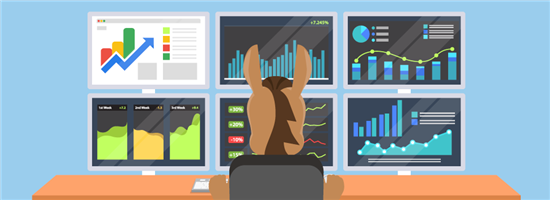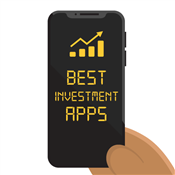Google Finance Portfolio Alternatives
Looking for a portfolio tracker to replace Google Finance Portfolio? Find out how these popular alternatives compare to choose the best tracker for you.
 |
Portfolio trackers make it easy to view your entire portfolio in one place. They're especially helpful if you have investments with more than one brokerage.
Google Finance Portfolio was a popular tracker. However, it was discontinued in 2017, leaving many investors looking for a replacement.
Review the best alternatives to Google Finance Portfolio in this guide. Plus, find out how to create a portfolio on Google Finance, if you want to stick with Google.
What is Google Finance Portfolio?
Google Finance Portfolio's popularity was largely due to its simplicity. You could load up all your holdings, and it would offer a daily snapshot of your portfolio's performance. You'd also see the largest contributors and detractors from your portfolio and relevant news headlines.
The Portfolio tool was discontinued in 2017 during a revamp of the Google Finance dashboard. Even without Portfolio, Google Finance is still a valuable tool with plenty of useful features.
If you're looking for a replacement, however, there are several alternatives to consider (both free and paid).
In 2017, they revamped their entire Google Finance app in an effort to make it more accessible and user-friendly for a wider audience, and unfortunately, this included the decommissioning of the Portfolio tool.
How Do You Make a Portfolio on Google Finance?
Even though the Portfolio tool is no more, you can still create multiple watchlists on Google Finance with your portfolio holdings. This won't give you overall portfolio metrics like their old portfolio tool did, but it will still show you the daily returns and news headlines for all your positions.
Creating a watchlist on Google Finance is easy if you have a Gmail account (and if you don't, creating one is easy and free).
- Visit Google Finance and locate "Your Watchlists" positioned in the top left corner of the page.
- Click on New watchlist.
- Next, give your watchlist a name, like "My Favorite Stocks."
- Finally, to add assets, simply tap Add investments.
Google discontinued their stock screener, along with its portfolio tool, as part of the revamp of Google Finance.
Google Finance Alternatives
Fortunately, there are quite a few portfolio trackers out there with similar functionality to Google's retired Portfolio tool. Below, compare some of the best options out there and why you might prefer one over another.
1. Yahoo Finance - For a simple platform
If you've ever looked up a stock quote online, you're probably aware of Yahoo Finance. The website is as easy to use as it is popular. Daily market headlines are front and center and your watchlist/portfolio is displayed vertically to the right along with their real-time performance.
It's also easy to link your brokerage accounts to Yahoo Finance so you can view your entire portfolio in real-time. Their platform supports most mainstream brokers, but they also give you the option to manually add holdings if you need to.
Once you have your portfolio set up, you get valuable details about each company and stock, like:
- Valuation metrics
- Trading range
- Charts and financials
- Opinions from other investors on the "Conversations" tab
These features are all free, but they also offer Yahoo Finance Plus plans which give you access to a few extras:
- Bronze plan ($9.95/month, $95.40/year)
Track portfolio performance, diversification, and risk exposure. - Silver plan ($24.95/month, $239.40/year)
Access to professional analyst ratings, premium news, portfolio strategies, and independent research to gain an edge. - Gold plan ($49.95/month, $479.40/year)
Create your own investing strategies with premium charts, smart screeners, and 40+ years of historical downloadable data.
This choice often comes down to personal preference, as both websites are established and offer mostly the same information. In most cases it's probably most convenient to go with the website where you have your email account.
2. Morningstar - For look-through functionality
Morningstar is well-known for their popular fundamental stock, ETF, and mutual fund rankings. They also offer a free portfolio-tracking tool called "Portfolio Manager," which allows you to track the daily performance of all your holdings in a single place.
One downside of their platform is that you need to manually load in each of your holdings, so there is some setup work involved.
Where Morningstar really shines is their premium subscription, which we think is better than Yahoo Finance Premium and more affordable at $199/year.
The Morningstar subscription includes an impressive tool/report called X-Ray.
This tool can look through all your stocks, funds, and ETFs to identify your portfolio's true exposures by asset class, region, sector, investing style (i.e., growth vs. value), and its valuation metrics (i.e., P/E and P/B ratios). Most platforms can't "see through" your mutual fund or ETF holdings.
X-Ray also breaks down the total expenses your portfolio is incurring through these pooled vehicles and will tell you how this compares to the average.
3. Empower - For a complete financial snapshot
Empower stands out from Yahoo and Google by including all your financial accounts (checking, savings, credit cards, loans, etc.) - not just your investments.
This makes it one of the most comprehensive dashboards available.
You get a view of your total monthly cash-flow for each account, broken out by expense categories like groceries, utilities, restaurants, clothing, etc. This gives you an immediate view into how much you are saving each month, or depending on the situation, how much you are spending over your income.
Empower also shows your investments across all accounts (IRA/401(k), taxable brokerage accounts, etc.), with allocations by asset class, such as U.S. and international stocks and bonds, and any alternative investments you have.
They also offer some unique tools to help you optimize your portfolio, such as a fee analyzer that reviews all your ETF and fund fees and recommends lower fee alternatives. You can also try out their Recession Simulator that will show how your portfolio would've performed during recent recessions.
4. SigFig - For a simple, free portfolio tracker
SigFig is similar to other robo-advisors that manage your money for a small fee, but they also offer a free portfolio tracker tool.
It's fairly basic and doesn't come with some of the bells and whistles you get with other paid subscriptions, but it gets the job done if simple is what you want.
You can link up all your different brokerage accounts on the SigFig platform and answer some basic questions about your risk tolerance and investing goals. Then, their portfolio tracker will get to work analyzing your portfolio's asset allocation, geographic exposure, and the fees you're paying.
If something seems out of place (e.g., if your stock exposure is high for someone who says they are risk-averse or if there's a cheaper alternative to one of your ETFs), it will let you know. You can also opt-in for a weekly email of your portfolio's performance, including the biggest movers and any relevant headlines.
5. MSN Money - For a user-friendly dashboard
In the same ranks as Google and Yahoo, MSN Money is Microsoft's version of your basic investing dashboard.
The left side of the dashboard will show your trending market news, followed by the performance of major stock indices, commodities, and currencies in the center. To the right is your personalized watchlist/portfolio that you can customize to your liking.
Like Yahoo and Google, MSN Money allows you to look at any stock and view all relevant financial data. This includes valuation metrics like the P/E and P/B, financial health indicators, ownership information, financial filings, and more.
6. Investing.com - For global-minded investors
Investing.com isn't as well-known as Google or Yahoo Finance, but they're one of the most comprehensive investing sites in terms of the breadth of content and securities they cover.
They offer real-time, streaming quotes and charts for basically everything:
- Global indices
- Stocks
- Futures
- ETFs
- Commodities
- Currencies
- Funds
- Bonds
- Cryptocurrency
And you can access all of this for free with ads (or pay $13.99/month, $9.99/month when paid yearly or $8.99/month when paid biennially, for InvestingPro to enjoy ad-free access).
You can also create your portfolio directly on their site to easily track all your investments in one place. Your portfolio can be entered manually or uploaded via CSV file. However, one downside is that we did not see an option to automatically link your brokerage accounts for a seamless user experience.
7. Finviz - For quantitative investors
Finviz is a solid option for its portfolio functionality and variety of free investor tools.
Like other portfolio trackers, Finviz lets you create multiple custom portfolios so you can track your overall performance over time.
What really sets Finviz apart from the others are the features that help you identify and add the right positions to your portfolio.
These tools include a quantitative stock screener where you can scan stocks by a variety of metrics, such as insider buying, analyst ratings, short percentage, valuation metrics, and even certain chart patterns. Other features include heat maps by sector or country.
If you decide to pay for an elite account (starting at $24.96/month), you'll have access to their "backtester" to see how different portfolios would've behaved in the past.
8. Wallmine - For smaller portfolios
Founded in 2018, Wallmine is first and foremost a portfolio tracker, which also offers a screening tool and a user-friendly way to search through SEC filings. Their portfolio tracker is easy to set up and use, as you can automatically link it to most brokerage accounts.
A big downside is that the free version of Wallmine limits you to two portfolios with up to 10 holdings each, with anything above this requiring you to upgrade to their premium version.
The premium version, priced at $50/month, makes Wallmine a costly option. It's best suited for smaller investors unwilling to invest in premium services, as the platform offers numerous equally effective tools for free.
9. Stock Rover - For advanced reporting
Stock Rover isn't as well-known as Google, but does have more functionality. This tool is for experienced investors who want to use data to make investment decisions.
Unlike Google Finance Portfolio, you can easily add your portfolio since it will link your brokerage accounts. But learning to use this more powerful tool will take some time.
Stock Rover's best features are the advanced charts and tables you can create from their extensive database. They track more than 700 metrics, with some having 10+ years of historical data.
Stock Rover has a free plan you can use to track stocks. Or access more data and tools with their paid plans costing $7.99, $17.99, or $27.99 per month.
Stock Rover Free
- Comprehensive information on over 8,500 North American stocks
- Coverage of 4000 ETFs and 40,000 mutual funds
- Portfolio management
- Portfolio Brokerage integration for automated syncing of portfolios
- Portfolio dashboard with detailed portfolio performance information
- Activates a 14-day free trial of Stock Rover Premium Plus
Stock Rover Essentials
- Easy comparison of investment candidates via the Stock Rover dynamic table
- Fully customizable financial views and columns
- 275+ metrics with 5 years of detailed historical data
- Easy to use, fast and flexible stock screening
- Portfolio and watchlist tracking
Stock Rover Premium
- Over 100+ additional metrics, 375+ in total
- 10+ years of detailed financial history
- Data export
- ETF and Fund comparison data
- Powerful Stock and ETF screening
Stock Rover Premium Plus
- Over 300+ additional metrics, 700+ in total
- Custom metrics
- Equation screening
- Historical data screening
- ETF screening with 180+ ETF specific metrics
Bottom Line
The bottom line is that for most everyday investors, one of the many free portfolio dashboards will work just fine.
For investors who just need basic portfolio tracking, quotes, and charts, you're probably choosing between the likes of Google, Yahoo, and MSN, and in many cases, the most convenient platform will be the one you are already using for email.
For investors who want a complete picture of their daily finances, a more comprehensive platform, like Empower, will make more sense.
And for the more hands-on investor who actively manages their portfolio, a site like Finviz or Morningstar would be attractive because of their portfolio-building and advanced analysis features.
Write to Andrew Fitzgerald at feedback@creditdonkey.com. Follow us on Twitter and Facebook for our latest posts.
Note: This website is made possible through financial relationships with some of the products and services mentioned on this site. We may receive compensation if you shop through links in our content. You do not have to use our links, but you help support CreditDonkey if you do.
Empower Personal Wealth, LLC (“EPW”) compensates CREDITDONKEY INC for new leads. CREDITDONKEY INC is not an investment client of Personal Capital Advisors Corporation or Empower Advisory Group, LLC.
|
|
| ||||||
|
|
|














